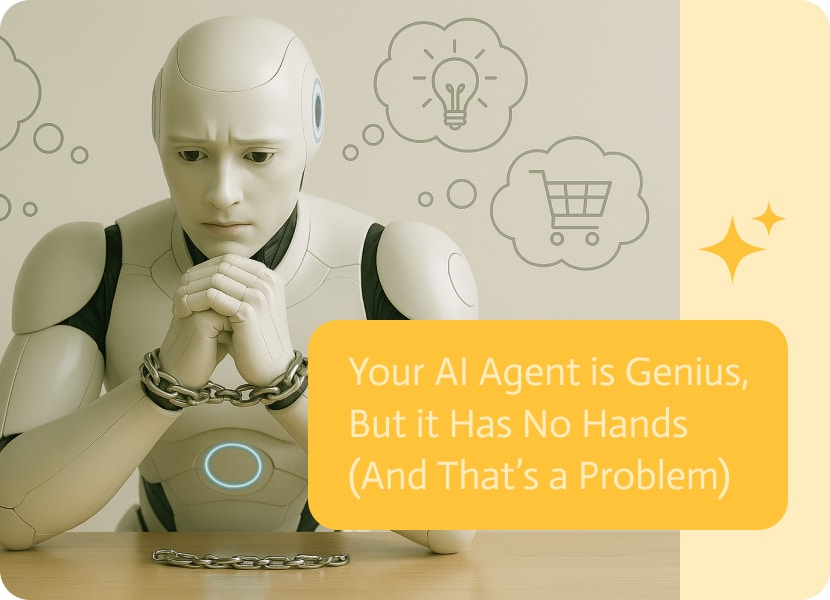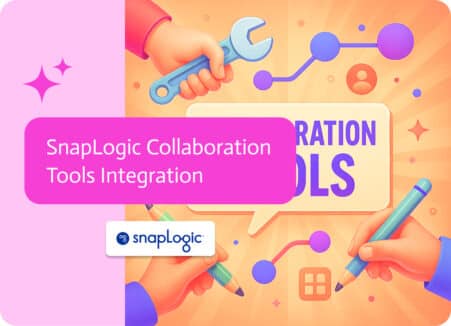

Your AI Agent is Genius, But it Has No Hands (And That’s a Problem)
We need to talk honestly about how AI is doing right now. Not the fast-paced, caffeine-fueled talk on Twitter/X, where every new chatbot update is treated like the discovery of fire. We need the “adult” talk that happens between the lead architect and the chief technology officer after the sales team has left the room.
We have created marvelous digital brains. The likes of those built by OpenAI, Anthropic, and Google are, to be frank, mind-blowing. They can pass the bar exam, write sonnets like Eminem, and fix Python code faster than a senior engineer on their third Red Bull.
But there is a big, structural problem that keeps getting omitted in the demo videos, these brains are floating in what can only be referred to as a void.
They are disembodied, stuck in a chat window. Yes, they’re downright geniuses, but they are missing hands, you know, those appendages with opposable thumbs that made man top of the food chain. And until we figure out the “hands” problem, your enterprise AI strategy is mostly just a very expensive way to send emails that you still have to copy and paste yourself.
The “Brain in a Box” Dilemma
envisage hiring the top business consultant on the entire planet. Let’s say you brought back to life a composite clone of Einstein, Peter Drucker, and your smartest operational manager. You hire this said genius, pay them a small fortune, and then you put them in a glass box in the basement that can’t be heard.
You don’t give them a laptop. You don’t let them use a phone. You don’t give them a badge to get into the archives. You don’t even give them a pen.
They can’t do anything but sit there. Put a piece of paper under the glass that says, “How do I fix our supply chain?” The genius reads it, thinks for a split second, and then slides a piece of paper back out that says, “Move inventory from the Midwest distribution center to the Northeast hub.”
Outstanding advice. But now you, the expensive employee, must trek over to your computer, log into SAP, figure out how to use the perplexing interface, and actually move the inventory. The genius didn’t do the work; they simply pondered about it.
The Friction of the Chat Interface
Here, we’re referring to the “Brain in a Box” dilemma. Most of the time, businesses only use chat interfaces to interact with artificial intelligence. You type a prompt, and it makes text, and then the process halts. The last part of the execution is given back to the person.
We want models to be agents, but we’re treating them like oracles. An oracle gives answers to questions. An agent makes things happen.
An AI needs “hands” to be an agent. It needs the following in technical terms:
- Authentication: The ability to sign in as a user.
- API Access: Able to comprehend other software’s languages (JSON, REST, GraphQL).
- Context: Able to understand the current configuration of a database, not just the training data from eons ago.
- Write Authorizations: The power to change reality with the push of a button.
Artificial intelligence is just a trick without these integrations. It’s not a solution for automating workflows; it’s a content generator. And that’s when the real nightmare in architecture starts: bridging that gap and giving the brain a pair of hands.
“Stranger Danger” in the API Economy (The Risk of MCP)
So, the business world has figured this out, and people are scrambling to build the “hands.”
The MCP and the rise of open-source tool libraries are two examples. The promise is tempting: a standard way for AI to connect to data and utilities. People are calling it the USB-C port for the artificial intelligence era. It’s a worldwide accepted protocol that effectively lets Claude or GPT connect to Google, Slack, Salesforce, or your own SQL database.
The open-source community has sent a lot of connectors to GitHub, as they usually do. You need a Notion connector? There is a library for that. Do you need an agent who can post on LinkedIn? Simply install this package that User492 wrote with npm.
The Open Source Trap
This leads us to the “grown-up” worry. As an architect, you don’t get excited when to see a standard protocol that lets an autonomous agent run code inside my firewall using libraries from the public internet, you feel a chill run down your spine.
We are walking into a minefield of supply chain security.
Anyone can help with open source, which is what makes it so great. The scary thing about open source is that anyone can help. You have to ask, “Who built those hands?” when you download a random MCP server or a tool definition to give your AI “hands.”
Did a security engineer from a well-known company write this connector? Or did a bored teenager in a basement in Bratislava write it and add a backdoor because he could? Or, more likely, did a well-meaning developer write it who just didn’t know how enterprise authentication standards work and left the token handling logic open to injection attacks?
The Park Bench Sandwich
Putting unverified libraries into your AI agents is just like seeing a half-eaten sandwich on a bench in a park and deciding to eat it for lunch.
It could be a tasty sandwich. It could be completely safe. But would you bet your stomach, or in this case, your business’s SOC2 compliance and customer data, on that chance?
When an AI agent has “hands,” it means it can delete files. It can send emails to customers. It can move money. If the connector code (the “hand”) is broken or hacked, the AI isn’t just seeing things that aren’t there; it’s also seeing things that are happening.
The “download and run” attitude of the current AI hype cycle is bad for business for this reason. We need provenance, we need actual proof. Agent tools need a “Blue Checkmark.” We need to be sure that the code that links our brain to our database is just as safe as the database itself.
Why We Need “Legos” Instead of Action Figures
After we get past the security issue, we have to deal with the product issue. How do we get these agents?
Right now, the market is trying to sell us “Action Figures.” You’ve seen them. The startup pitch decks that say things like “The World’s First AI HR Manager” or “The Autonomous SDR.” These are pre-made, inflexible software bots that are meant to do one thing. They look cool and have a specific uniform, but their joints only move in three ways, like action figures.
The Product Trap
The problem is that every business is different. Your “HR Onboarding Process” is like a snowflake. It includes a strange old spreadsheet from 2012, Workday, a Slack channel, and an email to the IT guy named Dave.
If you buy a rigid “AI HR Manager” (the action figure), it won’t fit your process. It will expect a normal world that doesn’t exist. You will spend more time trying to make your company fit the tool than using the tool to help your company.
The Lego Philosophy
The “Grown-Up” way is to say no to the Action Figure and ask for Legos instead.
We don’t need rigid, pre-defined agents. We need a bucket of bricks that are safe, verified, and easy to put together. We must have a platform that gives us the basic building blocks of agency:
- Trigger Brick: “When a new row shows up in this CSV…”
- Logic Brick: “If the feeling is bad…”
- “Draft a draft in Gmail…” says Action Brick.
- Action Brick: “Make changes to this field in HubSpot…”
You can make anything with Legos. This morning, you can put together a “Security Audit Bot” to look for open ports. This afternoon, you can take it apart and use the same bricks to make a “Customer Onboarding Bot.”
The Lego method’s main advantage is that it allows for composability. In a chaotic business setting, requirements shift on a weekly basis. An action figure can’t change. You can put together a Lego castle in an hour. We need platforms that keep the logic (the AI brain) and the tools (the API integrations) apart and let us mix and match them safely.
One Platform to Rule the Mess
So, what does the solution really look like if we don’t want to eat the “Park Bench Sandwich” or the “Brain in a Box”?
It looks like a platform for orchestration. A boring, safe, and dependable middleware layer that connects your apps to the LLM. It gives you the “hands,” but it wears gloves for safety.
When you have this safe, modular platform, the possible uses go from being science fiction to being useful in real life. Here is a quick look at what real, hands-on AI looks like in the business world:
The Janitor Agent cleans up data
The AI Strategy Consultant is in high demand. Everyone hates being the janitor. But 90% of business data is junk.
- The Build: A simple program that keeps an eye on a folder of CSV files that are being uploaded.
- The “Hands”: It opens the file and looks through the “Phone Number” column.
- The Brain: It finds mistakes in formatting, like missing country codes or using dashes instead of dots.
- The Action: It fixes the formatting, makes the data consistent, and saves the clean version to the “Processed” folder.
- Value: It’s not sexy, but it saves the data science team 20 hours a week.
Forms (The Gatekeeper Agent)
Your “Contact Us” form is full of spam and leads that aren’t good enough.
- The Build: An agent that stops the form from being sent via webhook.
The Brain reads the “Message” field. Is this a real person? Is it a sales pitch? Is it a lead that looks like a support ticket?
- The Action: Delete it if it’s spam. If you need help, make a Jira ticket. Send it to Salesforce and Slack the regional VP if it’s a lead.
Value: Salespeople stop looking for ghosts.
Automation (The Traffic Cop Agent)
You get tons of documents all the time, like invoices, contracts, and resumes.
- The Build: An agent keeps an eye on a central email inbox.
- The Brain: It puts the attachment into a category. “This is an invoice from Vendor X.”
- The Action: It gets the total amount. It signs in to QuickBooks. It makes the bill. It sends an email to the manager to get permission.
- Value: You could use the “Brain in a Box” to figure out how to pay a bill. The “Agent with Hands” just pays it.
Conclusion: Don’t buy any more gadgets
The hype cycle wants you to buy magic. It wants you to think that your business will run itself if you just sign up for enough AI tools.
But we technologists know that magic is just engineering that hasn’t been explained yet. And most of the time, unexplained engineering is a security hole that is about to open up.
Don’t buy AI gadgets that only do one thing. Don’t think that a chat window will fix your workflow issues. It’s not about a smarter chatbot in the future of AI; it’s about a smarter architecture.
Buy a bucket of secured Legos. Look for a platform that has safe, verified connectors (hands) and lets you connect them to the brain you want. After that, you can build anything you want. It may not be as flashy as the demos on Twitter, but it will work, unlike the demos.


